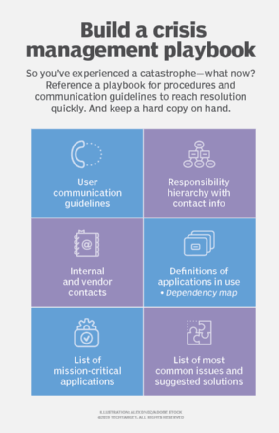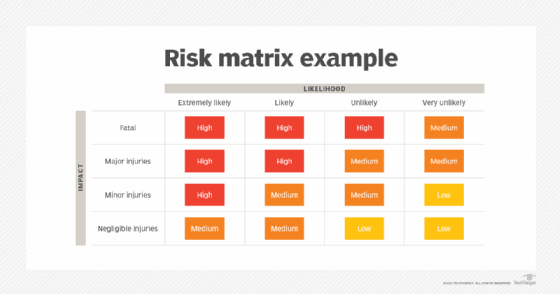emergency communications plan (EC plan)
What is in an emergency communications (EC plan)?
An emergency communications plan (EC plan) is a document that provides guidelines, contact information and procedures for how information should be shared during all phases of an unexpected occurrence that requires immediate action. A strong EC plan provides step-by-step instructions for how to deal with a crisis.
The need for an emergency communications plan
An emergency or crisis might hit an organization at any time. While no one can predict what kind of an emergency might arise and when, it is possible to prepare for it. Being proactive is the key to responding confidently to a crisis event and minimizing negative fallout.
In the event of a crisis, communication with all key stakeholders, including employees, top management, and board members is essential. It might also be necessary to inform third parties like vendors and customers.
An emergency communications plan is vital to help with planning for a future emergency and to facilitate information sharing during a current crisis. An EC plan provides a structured and detailed framework to deal with a crisis and communicate with stakeholders when it emerges.
The plan enables organizations -- in particular, the people in the organization dealing with the emergency -- to keep various stakeholders informed about the type of emergency, its possible impact on the organization and the actions being taken to mitigate the impact. The best EC plans also provide guidelines to help the organization prepare for future crisis events and prevent a crisis from occurring again.

A comprehensive EC plan identifies important people and their backups, explains how information should be communicated, and documents what procedures will be enacted to track and share company and individual employee status.
Additionally, the plan documents instructions for staying in place or evacuating the building. Should evacuation be necessary, the plan includes meeting points outside the building for employees to assemble and specify how status updates will be delivered to both employees and interested third parties.
In the event of an emergency, an effective EC plan can be launched quickly. It enables assigned personnel to brief senior management as soon as possible, communicate information to all interested stakeholders, and anticipate the need for changing communication channels as events develop.
Important parts of an emergency communications plan
EC plans differ depending on the organization, its business landscape and the specific emergency in progress. However, solid EC plans include all these sections:
- A list of possible emergencies the organization might face.
- A risk assessment of each identified emergency in terms of its likely probability of occurrence and expected impact.
- A list of emergency response personnel along with their up-to-date contact information.
- Evacuation routes and maps.
- Procedures to follow in the immediate aftermath of a crisis.
- Roles and responsibilities of emergency response personnel, including the emergency coordinator.

The response procedures might differ by emergency type so specific procedures must be created for each identified crisis. For example, an armed heist and an earthquake are both crisis situations for a bank. However, the former requires the involvement of law enforcement agencies, while the latter does not. The bank must have separate procedures in place to deal with both types of crises in an effective way that minimizes the potential damage.
Ideally, the EC plan must also include information about the following:
- Which external parties (e.g., law enforcement or regulatory agencies) must be involved in the emergency response efforts.
- Modes of communication to be used during the crisis: phone calls, text message broadcasts, etc.
- Provisions for containing the crisis, minimizing human injury and minimizing damage to enterprise assets.
- Staff evacuation guidelines, communication methods, routes.
- Safe locations for staff if the crisis could endanger them.
Best practices to follow when creating an EC plan
Before creating an EC plan, it's important to identify its objective and key stakeholders. This information will ensure that every part of the plan provides useful information and guidelines that help with crisis response and mitigation.
An effective EC plan should have the support of management and address a variety of emergencies, ranging from sudden severe weather to bomb threats to an active shooter in the building.
The plan should address ways both electronic and non-electronic communication channels can be used to disseminate information. This includes announcements over a building paging system, automated text messages, email alerts and prerecorded robocalls.
Should electronic communication channels be available, social media and the organization's website can also be used to communicate emergency information. Although automated emergency notification systems can enhance the EC plan, a traditional landline call tree should also be part of the plan in case internet or cellular service is disrupted.

It is also useful to script communication messaging in advance. Crisis teams should create message templates for each communication medium and stakeholder to ensure that appropriate messages go out quickly and reach the designated people when a crisis occurs.
Organizations should regularly test, review and update the plan, making sure everyone can perform their roles and responsibilities correctly. Exercises and drills should also be conducted to practice the plan and its procedures. These activities can help identify weaknesses in the plan and demonstrate the organization's level of preparedness to a real crisis.
Once the flaws are recognized, the plan must be modified. Thus, businesses can ensure that they are well prepared to deal with a future crisis and minimize any material damage that might arise from it.
Explore the key differences between business resilience versus business continuity and see where security fits into a business continuity plan. Learn five tips to ensure your crisis comms plan is ready for a cyber attack and see how to fortify emergency communications systems with a business plan.






